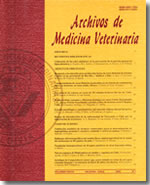Pesquisa de lasalocida y monensina en leche cruda de vacas lecheras suplementadas con estos ionóforos
Conteúdo do artigo principal
Resumo
Los ionóforos lasalocida y monensina han sido usados como aditivos en el alimento para mejorar la ganancia de peso en ganado de carne y la producción de leche en vacas. Los objetivos de este trabajo fueron detectar la presencia de estos compuestos en muestras de leche cruda y la tasa de desaparición ruminal, utilizando HPLC como técnica analítica. Dos rebaños de vacas Friesian fueron utilizados. Las vacas de cada rebaño fueron suplementadas con lasalocida y monensina por 18 y 21 días, respectivamente, a la dosis recomendada (300 mg/d). Las muestras fueron obtenidas diariamente durante el periodo de suplementación y la presencia de lasalocida y monensina fue analizada usando una técnica HPLC (LOD 30 y 5 ppb, respectivamente). En ensayos paralelos, empleando vacas fistuladas, se obtuvieron muestras de líquido ruminal durante 24 horas posterior a una administración intrarruminal de ambos ionóforos, las que fueron analizadas mediante la misma técnica. Ambos ionóforos no fueron detectados en las muestras de leche obtenidas durante el periodo experimental. La escasa transferencia de estos ionóforos a la leche podría estar relacionada a su baja tasa de absorción esperada acorde con sus propiedades fisicoquímicas. La lasalocida fue detectada en el líquido ruminal por 6 horas postadministración, mientras que para la monensina el tiempo fue de 4 horas. De acuerdo con los resultados no se detecta la presencia de lasalocida o monensina en muestras de leche cruda de vacas suplementadas, usando una técnica con límites de detección de 30 y 5 ppb, respectivamente.

